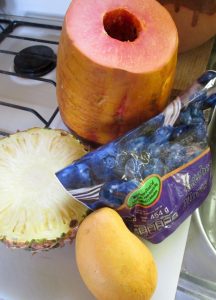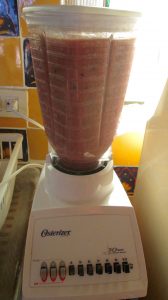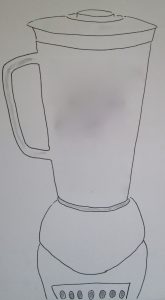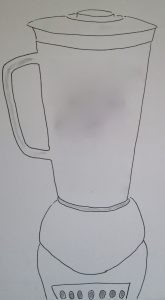Every morning now, when I make myself the healthy fresh fruit smoothie that I — and my body — have grown to love and rely on, I’m reminded of another time and place when I watched a blender whirl a lifesaving potion for a person I never knew.
That was in New York, during the AIDS epidemic that emerged in the 1980s, when I and other of my fellow food professionals in the City volunteered our free time to make healthy, hearty meals for homebound people with AIDS.
The nonprofit, non-sectarian organization we helped then was called God’s Love We Deliver and is still, thirty-five years since its founding, providing free meals made with care and delivered with love to New Yorkers in their homes who are too severely ill (with any illness now, not just AIDS) to shop or cook for themselves.
At that time, we cooked hundreds of meals in an old church’s basement kitchen on the Upper West Side. We made good food, comfort food, “mamma food,” we called it, such as meatloaf, mashed potatoes, gravy and green beans; thick, gooey, cheesy lasagna; a Jewish dish (I’ve forgotten the name of) made with bowtie pasta, barley, and saucy ground meat.
We made rich, chewy brownies; fat, nut-flecked chocolate-chip cookies; cream cheese-icing’d carrot cake — and so much more — all from scratch from our families’ heirloom recipes.
Each meal, as I recall — including homemade soup, main course, salad, and dessert — offered the recipient at least three thousand calories, because it would likely be the only meal he would eat that day. These meals helped to keep the men (yes, mostly young, gay men) alive.
Some of these men, slowly dying at home alone with HIV/AIDS, were too ill to chew. So one of the tasks that sometimes fell to me was to turn that day’s hot, just-cooked meal into nourishment they could more readily consume.
I have a clear memory of one day, one by one, placing each of those clients’ hefty servings of meatloaf, along with the buttery mashed potatoes, brown gravy and dark green beans, into an industrial-strength blender, covering it, pressing the button, and watching the colorful food turn into a thick, dull-gray mush. The sight of it turned my stomach.
But then I reached for a clean teaspoon and, with my eyes closed, I tasted the blended concoction. It tasted like my mother’s Sunday dinners in the ‘50s. It tasted like Home. Like Love.
This memory has returned to me every morning lately as I’ve made my breakfast, a blended, tropical-fruit smoothie, and then read in the New York Times online about New York’s latest scourge, COVID-19. After all its been through in recent decades – the AIDS crisis, the 9/11 attack — New York has now become the U.S.’s coronavirus hot zone.
This from one NYTimes article I read this week:
“Across the city, which has become the epicenter of the coronavirus outbreak in the United States, hospitals are beginning to confront the kind of harrowing surge in cases that has overwhelmed health care systems in China, Italy and other countries. On Wednesday evening [March 25th], New York City reported 20,011 confirmed cases and 280 deaths.”
And this from another NYTimes article this week:
“Once in the area, New York’s density played some role in its rapid spread […], epidemiologists said. Many New Yorkers live in high rises. Sidewalks are crowded. Subways can be jammed. The city has 27,000 residents per square mile, far surpassing the second densest city, San Francisco, with 18,000 per mile.”
Part of me is beside myself with worry, crying inside, “How will New York ever recover from this?” While another part of me, the New Yorker in me, stands up like a toughie and answers flatly, “Like we always do.”
I lived in New York, on the Upper West Side of Manhattan, which I’ve often felt was a microcosm of the world – filled with people from everywhere, people of every size, shape, color, age, ethnicity, language and religion — for twenty years, from 1976 until 1996, when I joined the Peace Corps at the age of fifty-one. I know that New Yorkers are made of sturdy stuff. They have to be.
New York is an education, like an advanced degree in sociology. It also teaches strength, resilience, and determination. It teaches street-smarts. It can teach compassion, too.
Take, for example, the woman who founded God’s Love We Deliver in 1985, Ganga Stone. As I recall the story, she began by making sandwiches for a man with AIDS who lived in her building. Then she made more sandwiches for his circle of friends who also had AIDS; and she delivered them herself, all over town, on her bicycle. Then she got some of her friends to help, and her charitable effort grew exponentially.
Today God’s Love We Deliver continues to feed thousands of homebound people living with severe illnesses in the New York metropolitan area every day.
For those who prefer recipes over memories or reminders of the harrowing coronavirus pandemic now raging through the world, here is my smoothie recipe for you to make at home, because we all must strive to maintain our physical (as well as mental, spiritual and emotional) health to the best of our ability. We must all try to become tough, resilient, determined-to-get-through-this New Yorkers.
In the bowl of a blender, add:
1 cup of water
1 packet of C-Boost (Mexico’s equivalent of Emergen-C)
1 scoop of vitamin/mineral powder (I use Multimix, from the Similares Farmacia here in San Miguel de Allende)
1 scoop of protein powder (from the health food store)
1/3 cup (or more) of frozen blueberries
1 slice of fresh, ripe pineapple
1 chunk of fresh, ripe papaya
1 one small, ripe mango (skinned and pitted, of course)
1-2 cups fruit juice (I use a combination of orange, mango, and cranberry juice)
Blend all until the mixture is a uniform, purple-y blue. Say grace. Drink slowly. And thankfully.




